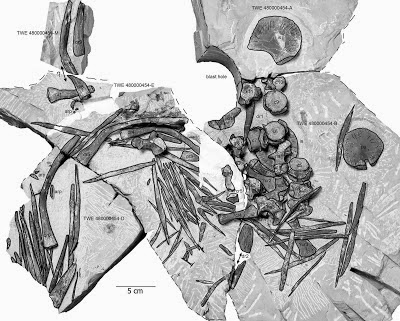In the early 1860s a 5 m Plesiosaur was excavated from the Early
Jurassic Blue Lias Formation at Street-on-the-Fosse in Somerset. This was
subsequently described as Plesiosaurus
megacephalus, and placed on public display at the Bristol City Museum and Art Gallery, where it remained until 24 November 1940, when along with many
other artefacts stored in the museum, it was destroyed in an air raid during
the Second World War, and apparently lost to science.
However prior to its destruction several plaster castes of the
specimen were made, three of which survive today in the collections of the
Natural History Museum in London, the Geology Museum at Trinity College Dublin and
the British Geological Survey at Keyworth in Nottingham, and several other
specimens from a variety of other Early Jurassic sights around England have
been nominated as potential members of the species.
In a paper published in the journal Palaeontologica Electronica in
April 2015, Adam Smith of the Nottingham Natural History Museum formally
redescribes the species from the available material, designating a neotype
specimen and evaluating which specimens that have been referred to the species
should in fact be referred to it.
Historical photograph of the holotype skeleton of ‘Plesiosaurus’megacephalus. Photograph
taken from glass plate negative in the Bristol City Museum & Art Gallery,
originally published by Swinton (1948). Length of skeleton equals 4960 mm.
Smith 2015.
In the 1860s little was known about Plesiosaurs, and the generic
name ‘Plesiosaurus’ was applied to
all specimens discovered. Since then it has become understood that these were a
large and diverse group of creatures, and split into several families and
numerous genera. The generic name ‘Plesiosaurus’
is now known to be quite inappropriate for the Street-on-the-Fosse specimen, as
it was a member of the family Rhomaleosauridae. It has also been referred to as
a member of the genera Rhomaleosaurus,
Thaumatosaurus and Eurycleidus, though Smith does not feel
that any of these designations are correct, instead creating a new generic
name, Atychodracon, meaning
‘Unfortunate-Dragon’, in reference to the destruction of the original specimen.
In addition to the original Street-on-the-Fosse specimen, a second
partial specimen from the same location has been referred to the species, as
have two specimens from Barrow-upon-Soar in Leicestershire (one more-or-less
complete and another partial and somewhat poorly preserved), and a complete
specimen from Wilmcote in Warwickshire. Smith excludes the Warwickshire
specimen from the species, believing it instead to represent a member of a new,
undescribed species, but includes all the other specimens.
In zoological nomenclature a type specimen, or holotype, is
designated when a new species is described, so that other specimens thought to
belong to the same species can be compared to it. In the event that this type
specimen is lost or destroyed the International Commission on ZoologicalNomenclature allows the designation of a new specimen as a neotype, so long as
it is possible to confirm that it belongs to the same species as the original
specimen. The plaster castes and photographs of the missing Bristol specimen of
Atychodracon megacephalus provide a
good reference point for establishing such a neotype, and Smith therefore
designates the more complete of the Leicestershire specimens to be the neotype
of the species.
See also…
The Plesiosaurs were Mesozoic marine reptiles that arose in the Late
Triassic or Early Jurassic and persisted till the Late Cretaceous. They
were related to modern lizards and snakes, but were fully aquatic, the
largest species reaching 15 m in length. All species seem to have been
strict carnivores, and at least...
 A Pliosaur from the Jurassic Coast of Dorset. The Pliosaurs were Mesozoic marine reptiles that arose in the Late
Triassic or Early Jurassic and persisted till the Late Cretaceous. They
were related to modern lizards and snakes, but were fully aquatic, the
largest species reaching 15 m in length. All species seem to have been
strict carnivores, and at least one species gave birth to live young.
Plesiosaurs are thought to have been fully aquatic from their first
appearance; they are...
A Pliosaur from the Jurassic Coast of Dorset. The Pliosaurs were Mesozoic marine reptiles that arose in the Late
Triassic or Early Jurassic and persisted till the Late Cretaceous. They
were related to modern lizards and snakes, but were fully aquatic, the
largest species reaching 15 m in length. All species seem to have been
strict carnivores, and at least one species gave birth to live young.
Plesiosaurs are thought to have been fully aquatic from their first
appearance; they are... New species of Placodont from the Middle Triassic of the Netherlands. Placodonts were a group of Sauropterygian Reptiles (a group related to
Snakes and Lizards that includes the better known Pliosaurs and
Plesiosaurs which survived to the end of the Mesozoic) from the mid-to
late Triassic. They were large animals, ranging one to...
New species of Placodont from the Middle Triassic of the Netherlands. Placodonts were a group of Sauropterygian Reptiles (a group related to
Snakes and Lizards that includes the better known Pliosaurs and
Plesiosaurs which survived to the end of the Mesozoic) from the mid-to
late Triassic. They were large animals, ranging one to...
Follow Sciency Thoughts on Facebook.


